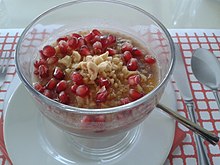Ottoman cuisine
[1] Many cookbooks were published beginning in the 19th century reflecting the cultural fusions that characterized the rich cuisine of Istanbul's elites in the Late Ottoman period as new ingredients like tomatoes became widely available.
[5][6] Diwan Lughat al-Turk (the earliest Turkish language dictionary) is often consulted as a source for the influence of Turkic cuisine, although scholars caution against uncritically assuming the words still meant the same thing hundreds of years later in geographically distant Anatolia.
[7] Ottoman cuisine represents the synthesis of Central Asian, Persian, Balkan, Arab and Byzantine culinary traditions, enriched by the introduction of new spices and ingredients during the Columbian Exchange.
Pilaf dishes exist in both Central Asian and Persian cuisine making it difficult to trace the path of diffusion back to its starting point.
[15] The influence of Ottoman cuisine in Europe beginning in the early 16th century is seen in dishes like sharbat, which spread first to Italy after Franceso I de'Medici requested a recipe for "Turkish sorbette" in 1577.
Similar to the Western-style confection nougat, koz halva is found in the cuisines of Central Europe, where it is called Törökméz ('Turkish honey') in Hungarian, and Türkischer Honig in Austria and southern Germany.
[20][21] The term "börek" does not appear in Kashgari's dictionary but two recipes for pirak are recorded in the 14th century Yinshan Zhengyao, a Chinese cookery manuscript from the Mongol Yuan era.
Istanbul's demand for grain could not be met by local production alone and it received shipments from the Thracian coastlands, western Anatolia, Dobruja, Macedonia and Thessaly.
[16] Dernschwam describes a baklava-like dish made by cooking thin wafers of starch flour and egg white, then filling with layers of sugared nuts with rosewater and nutmeg to create a dessert about as thick as a finger.
Dernschwam describes zerde as rice pudding that is cooked in honeyed water and colored with saffron, garnished with toasted almonds and served with fruits.
Cooked in a stoneware pan, the anchovies are arranged in rows and covered with a cinnamon and black pepper scented mixture of leeks, celery, parsley and onions.
Sugar was too expensive for all but the wealthiest members of Ottoman society, and desserts, compotes and sharbat were more likely to be sweetened with dry fruits, molasses or honey.
Cakes and bread with poppy seed filling had been consumed in Byzantium since Roman times, a tradition that continued under the Ottoman Turks, entering Central European cuisine and the related culinary culture of Ashkenazi Jews.
The recipe named "as the Turk likes it" from Hungarian noblewoman Anna Bornemisza's collection uses this technique:[38] Sprinkle salt on the meat then roast it.
[42] Ottoman court proceedings show that the boza peddlers claimed, by custom, exclusive rights to sell sauteed liver kebab (cığer).
[49] Hans Dernschwam, a 16th-century German traveler, confirms that çorba (Ottoman Turkish: چوربا) was a common dish of this period, prepared with butter and rice for the janissary corps.
The 16th-century Flemish herbalist and diplomat Ogier Ghiselin de Busbecq described the Ottoman culinary culture as "very frugal", with a simple meal of bread and salt, garlic or onion and yoghurt being all that was needed for nourishment.
[52] Lady Mary Wortley Montagu, writing in the 18th-century, says Ottomans use "a great deal of rich spice", and that she was unable to eat the food as the intensity of flavors took their toll on her and she "began to grow weary of it and desired our own cook might add a dish or two after our manner".
The recipe survives in Shirvani's 15th century manuscript, and some versions appear in Romanian cookbooks, most likely influenced by cultural contact with Hungary.
[55] Palace archives from the reign of Mehmed II confirm purchases of carrots, cucumbers, eggplants, parsley, spinach and chard in the late 15th century.
The creations of the Ottoman palace's kitchens also filtered to the common population, for instance through Ramadan events, and through the cooking at the houses (yalis) of the pashas, and from there on to the people at large.
Some large portions allotted to non-imperial high-ranking servants like the female steward of the harem, who received one sheep and 10 chickens per day, indicate that persons in these roles were responsible for feeding their subordinates.
Typical spices included cinnamon, clove, saffron, cumin, sumac, nutmeg, oregano, mastic, cardamom and black pepper.
At an 1856 banquet celebrating Ottoman victory in the Crimean War the alaturca dishes were savory börek pastry, pilaf and the desserts kadayıf and baklava.
Some of the dishes given French names were new creations of the palace kitches like croustade d'ananas en sultane and suprême de faisan à la Circassienne.
[70] At the Haseki Sultan Imaret in Jerusalem guests received two bowls of soup each day, enriched with clarified butter, and including legumes, grains, root vegetables and other seasonal ingredients, and always served with bread.
[70] All travelers were welcome to three days of basic meals at the imaret in Fatih, İstanbul, but the special service of bread, honey and sweets upon arrival was limited to guests of the caravansarai (roadside inn).
When members of the ashraf were in attendance, they were served sheep's trotters (paça) for breakfast each day, with hearty lamb and rice portions, and a spiced squash dish sweetened with honey, cloves and cinnamon.
Fragner notes that these cuisines, in the modern forms, "offer treacherous circumstantial evidence of this fact" of their shared cultural history, and that the origins of its legacy are impossible to ascertain: It is a matter of mere speculation whether the origins of this imperial culinary legacy are to be traced back to Greek antiquity, the Byzantine heritage, or the Turkish and Arab nations, not forgetting Phoenician traditions; nowadays you may find support for any of these claims in various countries in the Balkans and the Near East.
This has made the shared culinary heritage of these nations a flashpoint as competing nationalist agendas have fought over claims to the most prestigious dishes such as baklava.
















